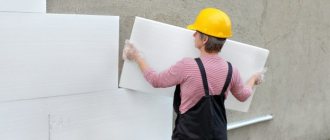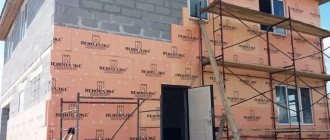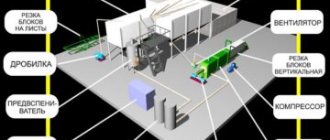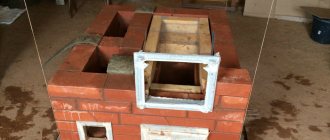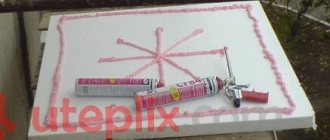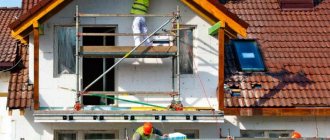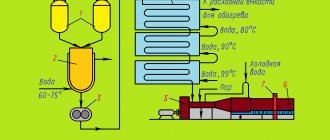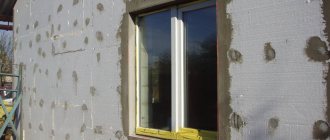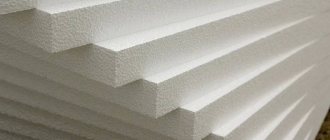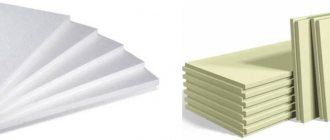Polystyrene foam (expanded polystyrene) is used in repair and construction. It is environmentally friendly and is used for thermal insulation. Properly selected adhesive for polystyrene foam will reliably bond it to any surface and extend the service life of the insulating structure.
Even a beginner can work with glue at home. Polystyrene foam can be glued to metal, wood, concrete, plastic, and connected to each other. Often attached to the ceiling in the form of ceiling skirting boards and tiles.
Features of installation of polystyrene foam
Extruded EPS is a high-density foam material. It is this indicator that distinguishes it from ordinary polystyrene - polystyrene foam. The density increases during the production process when passing through the extruder, this seriously increases the thermal insulation characteristics of the material. The final slabs consist of polymer and small air bubbles.
Due to the smoothness of EPS boards, they have very weak adhesion to the adhesive composition. This is the main problem when gluing. It can be solved by selecting special adhesives that themselves have high adhesion to any surface. Also, some products can partially dissolve the foam top of the slabs by being absorbed into them.
The specifics of installing polystyrene foam boards are as follows:
- if the material was purchased as floor insulation, it is laid on an expanded clay pad or on a pad made of other low-density material and filled with concrete;
- to insulate the foundation, the slab must be glued to the concrete of the base and secured with mounting fasteners;
- material is laid on the roof, then a layer of bitumen is placed or PPS is laid between the ribs of the rafters inside the roof layers;
- When insulating the ceiling in an apartment on the top floor, polystyrene foam is laid on the attic side with glue, then concreted or covered with crumbs, gravel, expanded clay.
Consumption per 1m2
Calculation of consumption per sq. m. is needed to determine the required amount of material to purchase. It is impossible to calculate the exact amount. This is influenced by factors:
- material, its density and ability to absorb;
- consumption of a specific type and brand of mixture.
The average data is shown in the table.
| Type of composition | Consumption |
| Dry | 500 gr. / m² |
| Bituminous | 800-1000 gr. / m² |
| Polyurethane | 1 cylinder per 8-10 m² |
Selecting adhesive for extruded polystyrene foam
How to glue polystyrene foam? To fasten the slabs, you can use different means that have different components. But there are specifics to using mixtures. So, it is better to use one for gluing to a concrete base, another for attaching to a brick wall, and another for winter work. There are adhesives that combine the properties of fastening material and insulation and have low thermal conductivity.
Before purchasing, it is important to clarify that the product contains no substances that corrode polystyrene foam. This:
- acetone;
- alcohol substitutes;
- toluene;
- esters;
- other solvents.
The ideal option is to purchase specialized formulations, because their manufacturers have already taken into account all the important points. There are three main types of products that are suitable for gluing material. This is a plaster-adhesive mixture of different brands, polymer adhesives and bitumen glue (mastic).
People often use “liquid nails” in a bottle, silicone sealants, frost-resistant tile adhesives, drywall and tile products for gluing materials. Can I use them? Experts say that the use of such adhesives is possible, especially if additional fastening of the structure with dowels is planned. But the cost of the work can be much higher, so it is better to buy products designed for XPS.
Main varieties
When choosing an adhesive for splicing plywood, you must take into account the requirements for the following compositions:
- ease of use;
- viscous or semi-viscous consistency;
- fast hardening;
- absence of volatile toxic substances in the composition;
- resistance to moisture;
- presence of antiseptic properties (not affected by bacteria).
For plywood that is located indoors, any compositions can be used. For splicing materials used outdoors, synthetic glue is suitable; for moisture-resistant boards, it is based on urea resin.
Aqueous or water-dispersed
Among similar adhesive compositions, PVA is most popular. These products do not contain toxic substances or components that emit unpleasant odors. The glue gains sufficient strength within a day, but it takes 2-3 days to completely harden. Due to the fact that PVA and other similar products are water based, these products cannot be used to bond plywood sheets with a porous surface that absorbs moisture.
Carpentry
The basis of carpentry compositions are fats of animal origin: casein and albumin. Both products are available in the form of a dry mixture, which must first be diluted in water. Albumin compounds are used for hot gluing, due to which the created joint gains strength faster.
Based on urea and phenol formaldehyde
Adhesives based on this type contain natural resins that are less toxic than epoxy ones. Compositions of this type are used exclusively for joining wooden products. Glue with such a base creates a transparent seam, so similar products are used to repair decorative elements.
Epoxy and polyurethane
The basis of such compositions are solvents containing toxic substances and emitting a pungent odor. Therefore, it is recommended to work with such products in ventilated areas or outdoors.
Epoxy adhesives are divided into one- and two-component. Compositions of the first type are immediately ready for use. Two-component products consist of an adhesive and a solvent, which must be mixed before starting work. Such compositions are used for rapid joining of various materials, including wood.
Plaster and adhesive mixtures
Such mixtures are suitable for gluing EPS to plasterboard, brick, concrete, and cinder block bases. You need to breed them yourself, since they are sold in the form of dry mass. The composition includes mineral components, plasticizers, Portland cement, and a number of auxiliary additives. The mixtures are suitable for exterior work and interior decoration; they will hide all the unevenness of the base. The downside is the need for preliminary deep priming of the surface.
Ceresit CT-83
"Ceresit ST-83" is widely used for pasting building facades. It has excellent frost resistance and adheres well to wood, concrete, plaster, and brick. After drying, ST-83 is breathable. Consumption per 1 sq. m is small, because it is enough to apply the mass 1 cm thick (this is done with a notched trowel).
The company also produces high-quality adhesive Ceresit CT 85, which is considered universal. High strength and ductility are due to the polymers included in the composition. But this product costs an order of magnitude more than the previous one, so builders prefer ST-83. Both materials are applied in intermittent stripes, slightly retreating from the edge for better air release.
Bergauf ISOFIX
Bergauf Isofix glue is a mixture of minerals, fillers, cement, sand, plasticizers, and special additives. Can be used for any indoor and outdoor use. Average consumption – up to 5.5 kg/sq.m. m, a thin layer (3 mm) is required. After dilution, the mixture is viable for 1.5 hours, it is possible to change the position of the plate on the wall within 25 minutes. The glue is sold in 25 kg bags and can glue extruded polystyrene foam to all types of surfaces.
Requirements
Expanded polystyrene (polystyrene) is a material that can be destroyed by solvents and other aggressive substances. Therefore, the composition should not contain:
- ketone solvents;
- acetone;
- nitrogen compounds (nitromethane, nitrobenzene);
- chlorine derivatives;
- gasoline, white spirit, kerosene;
- alcohol and ether components.
The scope of application must also be taken into account: for external or internal work. Outdoors and for facades you will need frost-resistant adhesive.
The packaging of each composition contains instructions for use. It indicates which substrates can be glued.
Polyurethane products
Any polyurethane adhesive is seriously different from the dry mixtures described above. They are often called “glue-foam”, “foam-glue”, because the compositions are sold in cylinders, and to use them you need a construction gun. They are used in the same way as polyurethane foam. Polyurethane adhesives for EPS are usually used for exterior applications; they have strong adhesion and are easy to use. The products dry quickly, are economical, do not react to changes in weather, and are frost-resistant.
Tytan Styro 753 GUN
Produced in 750 ml bottles, suitable even for interior work. This polystyrene adhesive is applied in thin strips, then the material is immediately applied to the wall. It can attach EPS to a base made of plaster, concrete, wood, mastic, cement, and is capable of reliably gluing sheets of expanded polystyrene together.
Adhesive foam "TechnoNIKOL"
TechnoNIKOL adhesive is widely used for fastening polystyrene slabs to foundations, walls of houses, roofs, in basements, and on floors. The gaps between the insulation boards are also sealed with glue. The adhesion of the product is high even where there is mold, high humidity, and fungus.
Glue "Penoplex" Fastfix
The product is considered effective for fastening EPS slabs to bases made of concrete, aerated concrete, brick, and ceramic blocks. Packaged in standard 750 ml bottles. It is characterized by high strength, the quality of adhesion to the base is one of the best among analogues. The adhesive is incompatible with bitumen compositions, polyethylene film, and Teflon.
How to glue foam
The gluing technology depends on the installation conditions of the foam and the material to which it is attached.
To the foam
Polystyrene foam is attached to other foam plastic using the adhesives described above.
There is a specialized brand called Styroglue. It will best glue together two parts of foam plastic and other substrates. It is not as widespread on the market as other brands, but the price is not the highest.
Advantages:
- Styroglue is transparent in structure and will be invisible on light or white polystyrene;
- it dries quickly (from 20 seconds to 1 minute);
- resistant to moisture, frost, fungal formations, used indoors and outdoors.
Flaws:
- It is necessary to work with protective gloves, the glue sets quickly and is difficult to remove from your hands;
- cold affects the properties of the glue, it becomes thicker. In cold weather, keep the container in heated water.
When using PVA, it is applied to both parts/surfaces. Allow time to dry slightly, then apply another layer and squeeze the parts for a few minutes.
The parts are also fixed:
- epoxy resin with hardener;
- glue sticks and a heat gun.
The heat gun is suitable for fastening several parts of polystyrene foam into one structure. Extremely hot hot melt adhesive can burn through the material. It hardens quickly, you have to work the same way.
The method does not require professional skills. A beginner can work at home.
When attaching regular foam to extruded foam, the latter is treated with a needle roller for better adhesion.
To concrete
It can be attached to concrete without lathing. Tools and consumables you will need:
- primer mixture;
- spatula (for application);
- electric drill with a mixing attachment (for mixing the solution);
- glue.
A powder mixture is selected for gluing . It is diluted with ordinary water. The proportions are indicated in the instructions. The water in the container is mixed with a drill with a mixing attachment and powder is gradually added. If you don't have a drill, replace it with a construction mixer. The mixture must be allowed to brew so that it acquires adhesive qualities.
The effectiveness of adhesion is achieved by preparing the concrete base. The surface is thoroughly cleaned, all dirt, dust, stains are removed, and a primer is applied.
Next, apply the mass onto the foam block:
- if the walls have slight unevenness and defects, the glue is applied in continuous lines, with indentations of 2 cm made from the edges of the sheet;
- when the walls are curved more than 2 cm, apply with dotted lines (to get rid of excess air);
- the middle of the slab is also lubricated with the solution.
The sheet is then pressed tightly against the concrete wall or floor. Excess glue that appears along the edges is removed with a rag.
Builders advise fastening polystyrene slabs with dowels in each corner and in the center.
In addition to the dry mixture, you can use adhesive-sealant, liquid nails and dowels, and a polyurethane-based composition.
To metal
It will be possible to properly glue the foam to the metal if you lay burlap between them.
The metal must be clean and free of traces of corrosion (rust).
For gluing the following are used:
- adhesive sprays (aerosol, in cans);
- silicone sealants;
- polyurethane foam or polyurethane based;
- powder dry compositions;
- small areas can be glued with double-sided tape.
The best option would be polyurethane aerosol adhesive, available in cans, or foam adhesive. The foam adhesive composition is especially good when installing foam plastic on surfaces that are located at an angle or have uneven surfaces. Foam is applied pointwise (minimum 5 points). Solid strips are smeared with powder solutions.
To the tree
Polystyrene foam can be attached to plywood, boards, lining, OSB boards. Polystyrene sheets are glued to wooden bases in the same way.
The only thing is that nuances are observed due to the characteristics of the tree.
- The wood is cleaned, dirt, dust, grease stains are removed, and completely dried.
- The wood is primed in two or three layers. It is advisable to apply an antifungal primer.
- When fastening under windows, a reinforcing mesh is applied to a wooden base using a stapler.
- The cracks and empty spaces are sealed with polyurethane foam. After the foam has hardened, excess parts are removed.
- Any protrusions and irregularities are corrected.
- If the wood is varnished, it must be removed, since the composition of the varnish coating can corrode the foam.
- It is better to attach polystyrene foam to wood using anti-fungal and anti-mold additives.
The adhesive mixture is applied in strips along the sheet. Indentations of 2 cm are made from the edges. Then diagonal stripes are drawn. The sheet is pressed against the wood, and any residual glue that appears is removed with a rag.
Bitumen adhesive Bitumast
Bitumast mastic is similar in properties to a plaster-adhesive mixture, but includes bitumen, which plays a binding role. The advantage of the glue is its excellent compatibility with extruded polystyrene foam; it adheres to the material for a long time without any complaints. The product also has waterproofing properties and protects the joints of external walls from moisture.
You can easily mix Bitumast, it takes a couple of minutes, you don’t need any special tools (you don’t even need a mixer). There is also no need to warm up Bitumast before use. The consistency is liquid, so apply in a thin layer. There is a significant disadvantage - the mastic sets slowly, and you will have to keep the EPP sheets from slipping for a long time.
The nuances of proper gluing and reinforcement of polystyrene
If you plan to glue products made of extruded polystyrene foam and conventional foam, the following nuances of the technology should be taken into account:
- polystyrene is processed using a needle roller for better adhesion;
- It is recommended to cover the foam with long-fiber paper.
If you need to solve the problem of how to increase the strength of a structure based on foamed polymers after gluing, you should use the following recommendations:
- in the case of interior decor or crafts made from foam plastic, the solution is to create an external reinforcing frame made of paper;
- if it is necessary to reinforce structural elements, it is advisable to use fiberglass.
Also, polystyrene foam can be “armored” using gypsum or acrylic plaster.
Polyvinyl acetate adhesives
Polyvinyl acetate is a transparent, elastic polymer produced by the polymerization of vinyl acetate. This glue is considered universal because it can bond any hydrophilic materials. These adhesives do not rot and prevent the appearance of fungus.
"Moment Joiner"
Universal polyvinyl acetate adhesive, widely used in repair work. It is packaged in containers of 0.1-30 kg, so you can easily select the required weight. “Moment Joiner” dries quickly, does not corrode surfaces, and holds expanded polystyrene sheets very reliably.
PVA-MB
Do not confuse the product with regular PVA glue. This material is a reliable polyvinyl acetate emulsion with a number of plasticizing additives in its composition. PVA-MB dries more slowly than Moment, but the seam is considered stronger. You should not buy glues that are too cheap; PVA is often counterfeited.
Useful tips
Recommendations from experts will help you choose the most suitable adhesive composition and glue the insulation as firmly and efficiently as possible:
- Do not buy cheap glue produced by a dubious manufacturer.
- Pay attention to quality certificates.
- The glue sold on promotion may be expired - be sure to check the numbers on the packaging.
- The mixture should be stored in a dry place in pallets and sealed. If storage conditions are violated, the technological properties of the product will suffer. If saturated with moisture, it will become unsuitable for use.
- Do not dilute the hardened mixture with water, as this will cause the surface to subsequently crack and lose the properties of the product. Any unusable material must be discarded.
- During fixation, air circulation must be ensured indoors.
- Before installing insulation on metal surfaces, it is recommended to cover them with burlap. This will make it easier to attach the slabs and improve the quality of the connection.
It is better to insulate a house in the warm months of the year, when the weather is good outside, since it is difficult to work in rain and wind.
Expanded polystyrene boards are approximately 95% air, making the material lightweight and easy to cut and otherwise machine.
Expanded polystyrene boards have excellent sound insulation properties and excellent thermal insulation characteristics.
The scope of application of extruded polystyrene foam is extensive: it is widely used for internal and external thermal insulation of buildings, insulation of floors and roofs; expanded polystyrene slabs are the main element of modern sandwich panels used in frame construction.
The material is laid using the adhesive method, and when performing the work, a special assembly adhesive for extruded polystyrene foam , which allows you to obtain a reliable connection of the insulation board with wood, brick, concrete, metal and other surfaces.
Other gluing methods
Some craftsmen try to use “homemade” methods for attaching polystyrene boards using other methods. This is not always reasonable.
Polyurethane foam
Foam is used to fasten any surface, including EPS. The cost of foam is often cheaper than similar glue in cans. But the disadvantages of this method are obvious:
- slow setting with the base - slabs lying vertically will constantly slide;
- the glue contains special adhesion-improving additives, which makes it more reliable for tearing than foam;
- polyurethane foam tends to grow in volume, and when constructing polystyrene foam this can play a bad role;
- foam peels off the wall faster than glue.
The advantage of foam is the ability to fill the seams between the slabs, so it can also be useful in installation.
Characteristics of the material and indications for gluing
Among the offers of the specialized market, with the help of specialist recommendations, it is easy to choose the current option for effectively gluing foam plastic together. Polystyrene foam - foamed plastic - is made on the basis of various building polymers in the form of polystyrene, polyurethane, polyvinyl chloride, polyethylene. The material is characterized by low specific density and impressive heat resistance parameters. These properties are due to the fact that the cellular structure provides an air mass of 98% of the total volume.
Foamed polymers are relevant in the manufacture of finishing resources, insulators, and packaging products. Modern technologies also make it possible to use foam plastic as structural materials. Decorative elements for the interior and exterior are cast from it, packaging for furniture, technical equipment and food products is produced, and structural panels are produced.
Installation of foam plastic products is carried out mainly using the technology of gluing elements. This allows you to create a monolithic structure in which surface integrity defects are excluded.
The mechanical method of connection suffers from the possible formation of cracks, cold bridges or other hidden problems, while when gluing foam elements together, any threats of this kind are neutralized.
General information
Characteristics of penoplex
Penoplex can also be called extruded polystyrene foam. This is a popular material in the construction market. It has high thermal insulation properties. It is widely used for insulating facades and roofs, as well as for interior work. The production of expanded polystyrene began in 1941 in the USA. It obtained its technical properties thanks to the most complex processing using extrusion.
Feedstock is placed into the reactor and subjected to high temperatures and pressure. As a result, the existing components are saturated with a gaseous component. When the pressure is released, the mass begins to expand, forming foam. At the same time, the temperature decreases, which turns the substance into a solid. The mass is passed through extruders. It becomes like multilayer plastic. Most of the extruded polystyrene foam is occupied by air, purified from water vapor and having low thermal conductivity.
High production technology makes it possible to obtain a material that does not allow gases and water vapor to pass through, even if the installation of penoplex was carried out incorrectly. Closed cells of penoplex measuring 0.1–0.2 mm are filled with liquid when exposed to moisture. The water does not pass further and remains in the pores.
Advantages and disadvantages of penoplex
Extruded polystyrene foam
EPP does not deform and serves reliably for a long time. He is not afraid of temperature changes. It does not lose its properties from – 100 to + 75 degrees. It can be installed even in the harsh North.
The antiseptic properties of polystyrene foam lie in the fact that it is not at all susceptible to rotting. Working with him is a pleasure: installation is easy. Penoplex slabs do not cause allergic reactions upon contact with it.
Penoplex
The material is light and has a small thickness from 20 to 150 mm. The price-quality ratio pleases consumers. Extruded polystyrene foam is inexpensive and can be purchased by many who decide to renovate a private home or build a new residential building.
Comparison results
But extruded polystyrene foam also has a number of disadvantages: it is susceptible to combustion, is susceptible to exposure to infrared rays, and at temperatures above + 75 degrees it releases substances harmful to human health. One of the important disadvantages of expanded polystyrene is its destruction under the influence of solvents and abrasives. Therefore, a number of requirements are imposed on adhesives for extruded polystyrene.
What kind of glue should be used for extruded polystyrene foam?
Adhesive for penoplex must have the following qualities:
- moisture resistance;
- resistance to temperature changes;
- high adhesion;
- do not emit harmful substances;
- do not be too liquid so as not to leave drips.
Prohibited components of polystyrene foam adhesive
Penoplex adhesive should not contain certain components that negatively affect the structure of the materials, corroding it.
The composition of the adhesive for extruded polystyrene foam should not include:
- solvents;
- formaldehyde and formaldehyde;
- aromatics such as benzene and toluene;
- polyester and coal tars;
- flammable substances: gasoline, kerosene, diesel fuel.
Gluing “relatives” together
Bonding foam and extruded polystyrene foam. Sometimes during the production of thermal insulation it is necessary to glue foam insulation onto polystyrene foam. The same compositions are used for this. Since the source materials of both insulation materials are the same. Before gluing extruded polystyrene foam, treat its glossy surface with a needle roller to increase adhesion with the composition used.
Selecting the correct adhesive for polystyrene foam based on the specific situation will ensure reliable fixation of the slabs without loss of insulation quality.
Types of fixation
In order to fully take advantage of all the potential and benefits of insulating a building with penoplex, it is necessary to properly fix it on the working surface. There are two main methods of fixation:
In the first case, it is assumed that holes are drilled in the wall to a certain depth, followed by driving in special plastic dowels with a wide head. The plastic base is then securely fixed using steel pins, which act as a core, expanding the plastic shell from the inside.
Apart from the imaginary advantages of the reliability of this type of fixation of penoplex panels, this method does not have any other advantages. But as disadvantages, obvious points can be noted:
- the process is very labor-intensive and requires a special tool, at least a drill with impact mode or a hammer drill. You often have to drill holes in concrete, so it's worth having at least a couple of spare drill bits;
- constant noise during operation. First the sounds of a hammer drill, and then the blows of a hammer when dowels and steel cores are driven in;
- high consumption of material (meaning fasteners). To properly fix a small foam board measuring 60x60 centimeters, you need at least 5 dowels (4 at the edges and at least 1 in the center). The larger the panel size, the more fasteners may be needed;
- high cost of work. One dowel is inexpensive, but considering their number, the amount adds up to a decent amount, especially with a large insulation area.
Scheme of application of various brands
The following key types of expanded polystyrene are produced, differing in density and other characteristics:
- PSB-S-15, the density of this brand of foam is up to 15 kg/cu.m.
- PSB-S-25, from 15 kg/cu.m. up to 25 kg/cu.m.
- PSB-S-35, from 25 kg/cu.m. up to 35 kg/cu.m.
- PSB-S-50, from 35 kg/cu.m. up to 50 kg/cu.m.
The thermal conductivity component of foam plastic, expressed in digital values, refers to the range 0.037 W/mK - 0.043 W/mK. The indicated value can be correlated with the thermal conductivity of air, which is equal to 0.027 W/mK.
Use of polystyrene foam PSB-S-15
Polystyrene foam PSB-S-15 can be used for insulation of house facades. This type of insulation is practically not used in construction. It is used in structures that are attached to structures. These can be open balconies or verandas that serve a decorative function. Using PSB-S-15 foam plastic, shapes for facades are formed, and this allows:
- frame the corners of the house, windows;
- separate floors by creating cornices.
What is PSB-S-25 suitable for?
Plates with a density of 25 are used to insulate the facades of a house. The standard is foam plastic, the thickness of which is 5 cm. This type of insulation is used for many purposes. Its thickness can be changed - this will depend on consumer preferences.
Polystyrene foam of maximum thickness can be used to insulate walls that are exposed to atmospheric agents. They can also be used to insulate walls, since such material perfectly prevents the appearance of fungus.
Based on the designation of the material, it is used in various construction structures, and this does not impair its quality characteristics.
Application of polystyrene foam PSB-S-35
Before choosing insulation of the required thickness, it is recommended to find out in advance how much gas pipe is available, because under no circumstances should it be covered, as this may disrupt the aesthetics of the appearance of the building. In this case, it is advisable to prefer PSB-S-35 material with a thickness of 5 cm over material with a density of 25 and a thickness of 10 cm, especially since their prices are practically the same.
Insulation with a density of 35 can be used to insulate the slopes of windows and doors, and the facades of buildings. As a rule, it costs twice as much as the same polystyrene material with a density of 25. With a thickness of 5 cm, it can be used to insulate non-residential structures and garages. With a thickness of similar insulation of 7 centimeters, it can be used for thermal insulation of residential premises.
Due to the normal level of density, it is possible to use a heat insulator with a minimum thickness, which does not imply a deterioration in the quality of insulation. If the polystyrene foam heat insulator turns out to be harder, then it can be used to provide ideal insulation of basement walls and foundations.
Linoleum
It is very convenient and reliable to fix linoleum on a concrete floor with glue. The managers of the store where the flooring will be purchased will tell you how to glue linoleum to concrete. Linoleum manufacturers strongly recommend purchasing glue along with it.
Typically, linoleum is fixed to concrete using mastic. Its advantages:
- You can choose the right quality according to the type of linoleum. The fabric base of linoleum requires the use of dispersion glue, and in the absence of a base, synthetic mastic is used.
- The compositions of all adhesives have excellent characteristics in terms of waterproofing properties, strength, and water resistance.
- Resistant to environmental influences.
In addition to their composition, mastics also differ in purpose. There is a mastic for fixing that has increased stickiness and is economical in consumption, and for continuous gluing, the one that should be applied to the floor in an even layer over the entire area is suitable. The thickness of the layer depends on the brand of mastic.
